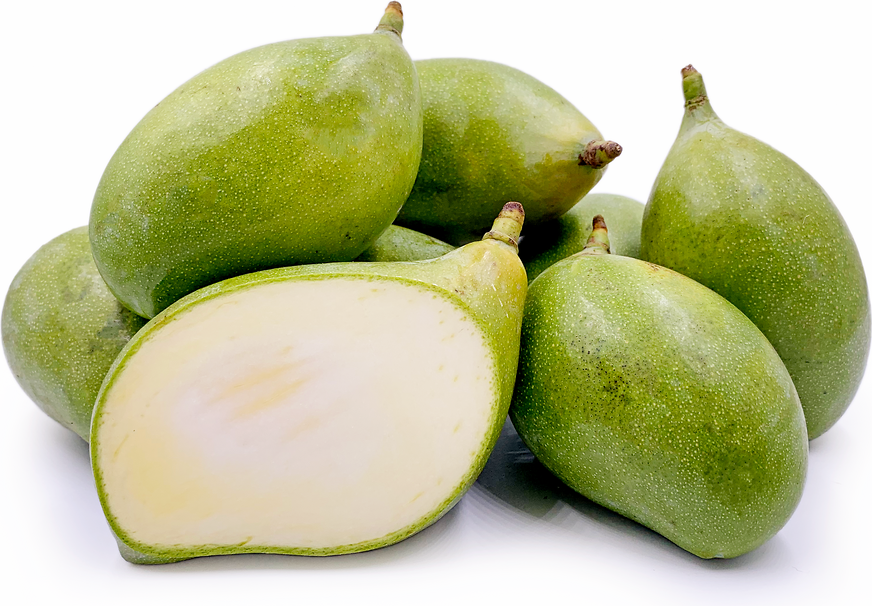


Raw Mangoes
Estimated Inventory, lb : 0
Description/Taste
Raw mangoes, picked when just mature, are also known as “Green mangoes.” Mangoes grow at the ends of long stems on evergreen trees in sub-tropical and tropical regions around the globe. Raw mangoes are firm and can be oval or slightly kidney bean-shaped, depending on the variety. The mangoes aren’t fully developed, so the seed is small and thin and the firm flesh is crisp. The flavor is sharply sour and can be slightly bitter due to concentrations of oxalic, citric and other types of acids which aren’t present in a ripe mango. The skin of some varieties of raw mango contain oils that can be irritating to those who have a sensitivity to poison ivy or oak, which is a distant relative of the mango. However, those with sensitivities to the skin generally don’t experience any irritation from the flesh.
Seasons/Availability
Raw mango is available year-round.
Current Facts
The name “Raw mango” refers to the unripened tropical fruit. Mangoes, botanically known as Mangifera indica, have both culinary and nutritional applications at every stage of ripeness. Raw mangoes are picked when just mature, and must be used before they begin to ripen. Mangoes are often referred to as the “king of Asiatic fruit” for both their nutritional and historical and religious reverence in India.
Nutritional Value
Raw mango is high in both vitamins C and B, far more than when it is fully ripe. Raw mango is high in pectin and starch, which eventually turns into glucose when the fruit is ripe. Mangoes contain healthy enzymes that are beneficial for digestion.
Applications
Raw mango can be used in a variety of ways. Wear gloves to protect hands from the potentially irritating skin of the raw mango. To prepare the Raw mango, cut a small piece from the bottom, or beak, for stability while cutting. Locate the seed in the center, and remove both halves around the stone. Specialized mango cutter or slicers are sometimes used to maximize the amount of flesh. Once the stone is removed, the flesh can be scored and removed from the skin. Diced Raw mango can be added to both hot and cold dishes. Mangoes are a good addition to marinades and because of the different enzymes they contain, they are good tenderizing agents for steaks, poultry or pork. Grate Raw mangoes for salads or slaws. Raw mangoes are used in a traditional Indian dish called pulusu, a soup cooked with drumstick, curry leaves, tamarind and served over rice. Raw mangoes should be used before they begin to ripen, which can be up to five days when the fruit is kept at room temperature. Prepared fruit should be refrigerated and used within a day or two.
Ethnic/Cultural Info
In India and Pakistan, a refreshing drink is made from the Raw mango. The libation is most often prepared in the summer, when the heat is at its peak. Raw mango is peeled, deseeded and grated then cooked with jaggery, a raw form of sugar, and water. The puree is mixed with cumin, aniseed, and black pepper and then chilled and strained into a glass. Often used to cool the body during extremely hot weather, the Raw mango is believed to protect from the negative effects of extreme heat.
Geography/History
Mangoes originated in Southeast Asia over five thousand years ago, in an area that extends from eastern India to southern China. The mango seeds are large, so historians believe the tropical fruit spread around the globe by sea via explorers and sailors. The Portuguese were instrumental in the spread of mangoes; they were the first to establish a mango trade after establishing a colony in western India in the late 15th century. In the 17th century, Spanish explorers brought the seeds to what is now Central America. Though 35 varieties are currently being cultivated in the tropical regions around the world, over 500 varieties of mango exist. The biggest growing areas outside of India include Haiti, Mexico, Brazil, the Philippines, and China. The United States grows mangoes in Hawaii, Florida and Southern California to a lesser degree.
Recipe Ideas
Recipes that include Raw Mangoes. One
| Rak's Kitchen |
|
Mango Thogayal |
| Veg Recipes of India |
|
Mango Chaat |
| Sailu's Kitchen |
|
Vankaya Mamidi Pachadi ~ Eggplant-Raw Mango Chutney |
| Chef In You |
|
Aam Ka Panna (Spiced Green Mango Juice) |
Podcasts

















